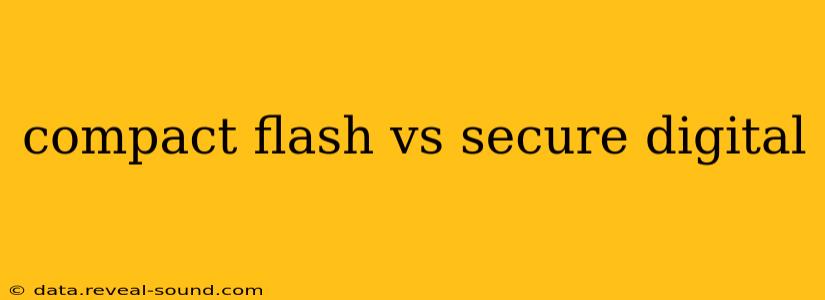Choosing the right memory card can be crucial, especially for photographers, videographers, and other professionals who rely on fast, reliable storage. Two prominent contenders in the memory card arena are CompactFlash (CF) and Secure Digital (SD) cards. While both offer substantial storage capacities, they differ significantly in performance, physical size, and applications. This detailed comparison will help you understand their strengths and weaknesses, ultimately guiding you to the best choice for your needs.
What is CompactFlash (CF)?
CompactFlash, introduced in 1994, is a relatively older memory card format. Known for its robust build and high data transfer rates, particularly in its professional-grade variations like CFexpress, it has traditionally been the preferred choice for high-end digital cameras, especially those requiring extensive burst shooting capabilities and fast continuous shooting. However, its larger physical size and less widespread adoption compared to SD cards are notable drawbacks.
What is Secure Digital (SD)?
Secure Digital, first launched in 1999, has become the de facto standard for memory cards in many devices. Its smaller size, compatibility with numerous devices (cameras, smartphones, tablets, etc.), and diverse range of speed classes and formats (SD, SDHC, SDXC, SDUC) have made it incredibly popular. From everyday point-and-shoot cameras to professional DSLRs, SD cards are ubiquitous.
CompactFlash vs. Secure Digital: Key Differences
Here's a breakdown of the major differences between CF and SD cards:
1. Physical Size and Durability:
- CompactFlash: Larger and generally more robust, making it suitable for demanding environments. Its thicker build offers better protection against bending and damage.
- Secure Digital: Smaller and more compact, making it ideal for portable devices. However, its smaller size can make it more susceptible to damage from bending or physical impact.
2. Speed and Performance:
- CompactFlash: Historically known for faster speeds, particularly the professional CFexpress type. This makes it suitable for high-resolution image capture and 4K or even 8K video recording.
- Secure Digital: While slower than professional CF cards in the past, high-end SD cards like SDXC UHS-II and UHS-III now offer speeds comparable to, and sometimes exceeding, those of standard CF cards. The introduction of SD Express further blurs the lines.
3. Cost:
- CompactFlash: Generally more expensive than SD cards of comparable capacity. This is partly due to their more niche market.
- Secure Digital: More affordable and widely available, leading to increased competition and lower prices.
4. Compatibility:
- CompactFlash: Compatibility is generally limited to professional-grade cameras and some specialized devices.
- Secure Digital: Far more widely compatible with a broad range of devices, including cameras, smartphones, tablets, laptops, and more.
5. Capacity:
- CompactFlash: Offers high storage capacities, similar to SD cards, although the maximum capacity may vary across different types of CF cards.
- Secure Digital: Supports high storage capacities, constantly increasing with technological advancements. SDUC cards offer particularly high capacities.
Which Memory Card is Right for You?
The "best" card depends entirely on your specific needs and priorities:
-
Choose CompactFlash (especially CFexpress) if: You need the absolute highest speeds for professional-grade photography or videography, particularly high-resolution still shooting and high-bitrate video recording. Robustness is a priority.
-
Choose Secure Digital if: You need a widely compatible, cost-effective, and readily available card for a variety of devices. Size and portability are important factors.
Frequently Asked Questions (FAQ)
What is the fastest type of CompactFlash card?
The fastest type of CompactFlash card is CFexpress, offering significantly higher speeds than traditional CompactFlash cards.
What is the difference between SDHC and SDXC cards?
SDHC (Secure Digital High Capacity) cards have a storage capacity of up to 32GB, while SDXC (Secure Digital eXtended Capacity) cards have capacities exceeding 32GB, up to 2TB or more.
Are CompactFlash cards still used?
Yes, CompactFlash cards are still used, particularly by professional photographers and videographers who require high-speed performance and reliability. However, their market share is diminishing compared to SD cards.
Can I use a CompactFlash card in an SD card slot?
No, CompactFlash and SD cards have different physical interfaces and are not interchangeable. You'll need a card reader capable of handling both formats if you need to access data from both.
What is the future of CompactFlash and SD cards?
The future likely sees continued evolution of SD cards with ever-increasing capacities and speeds (SD Express), while CompactFlash might become increasingly niche.
By carefully considering your specific requirements and weighing the advantages and disadvantages outlined above, you can make an informed decision between CompactFlash and Secure Digital cards, ensuring you choose the optimal memory solution for your needs.
